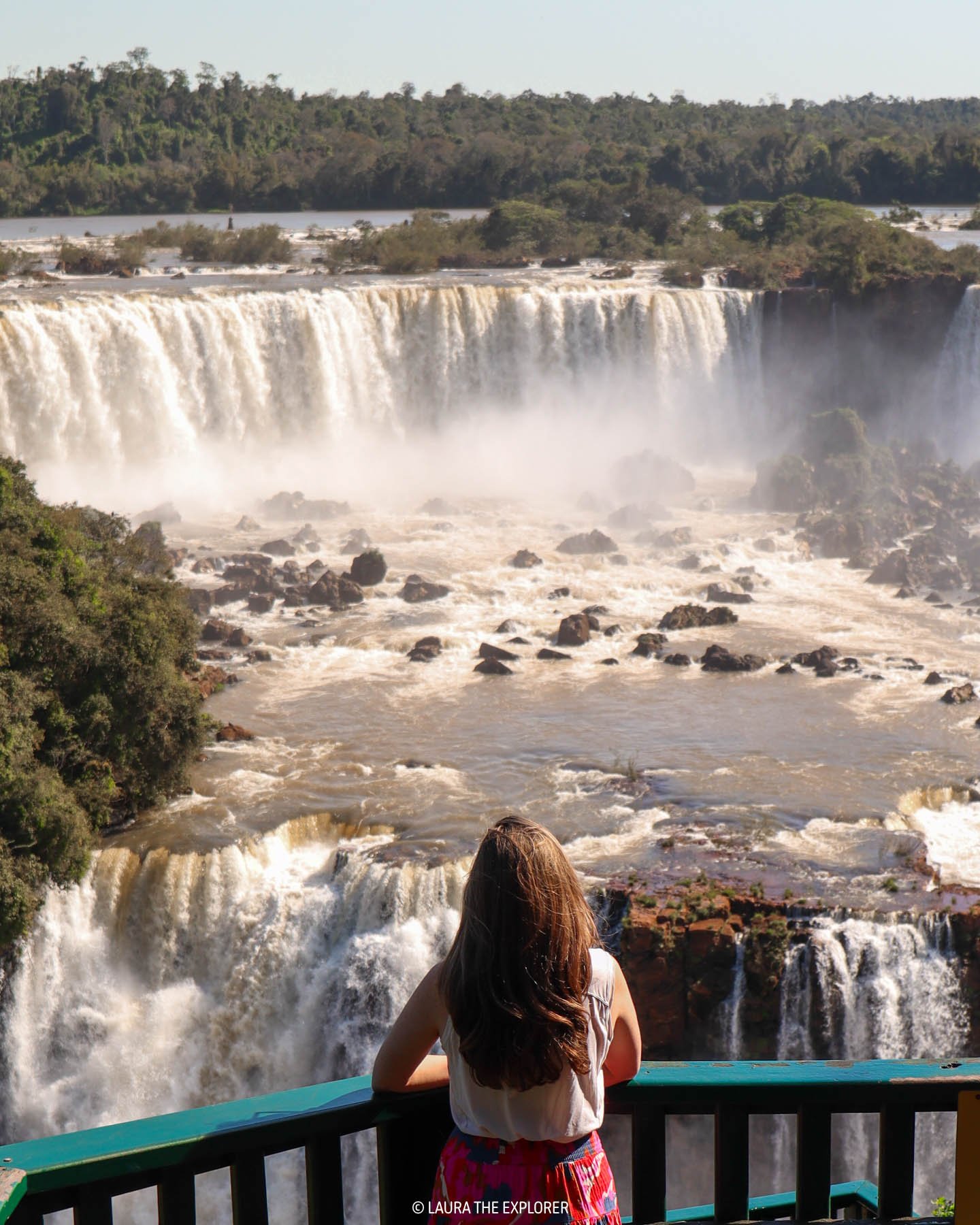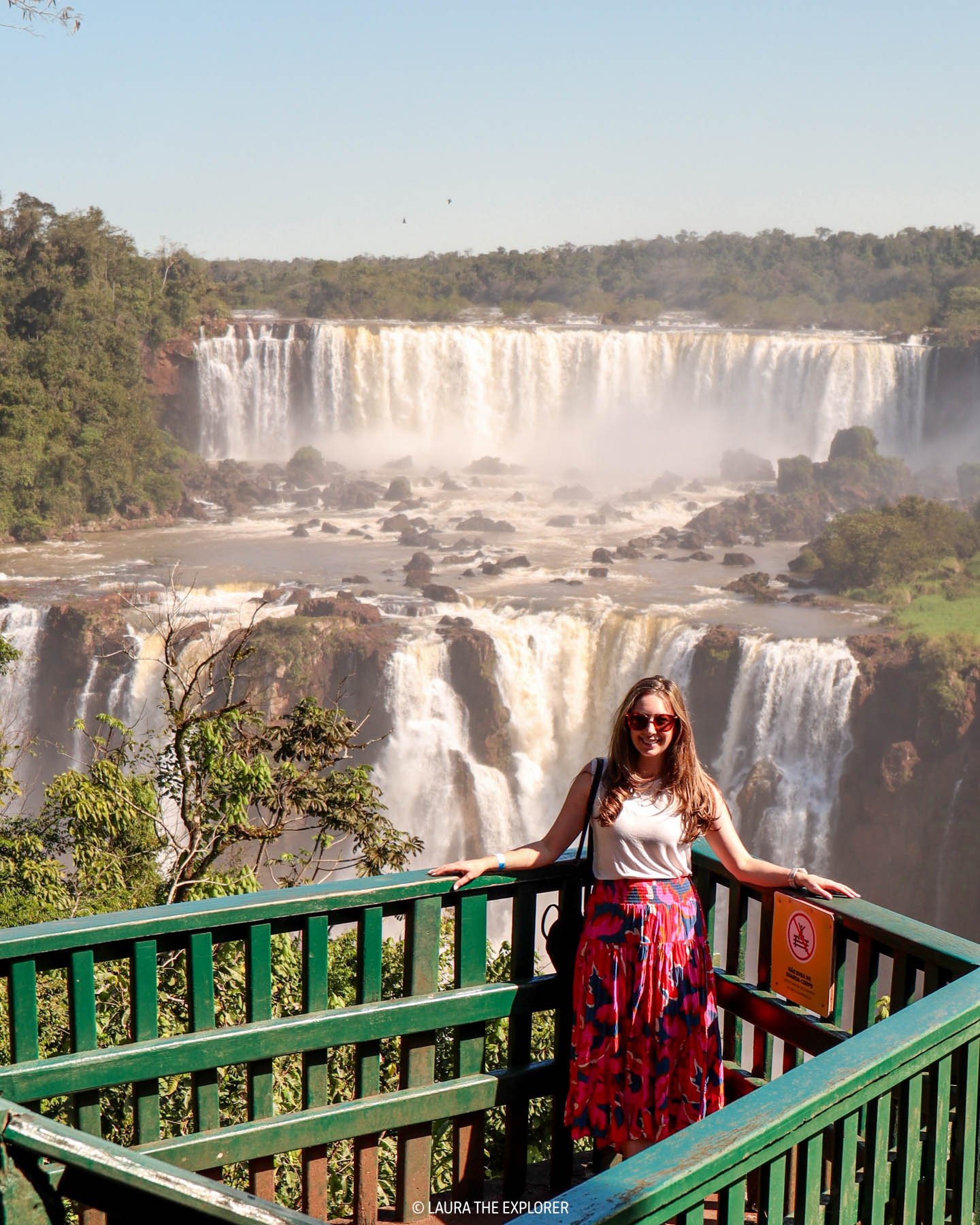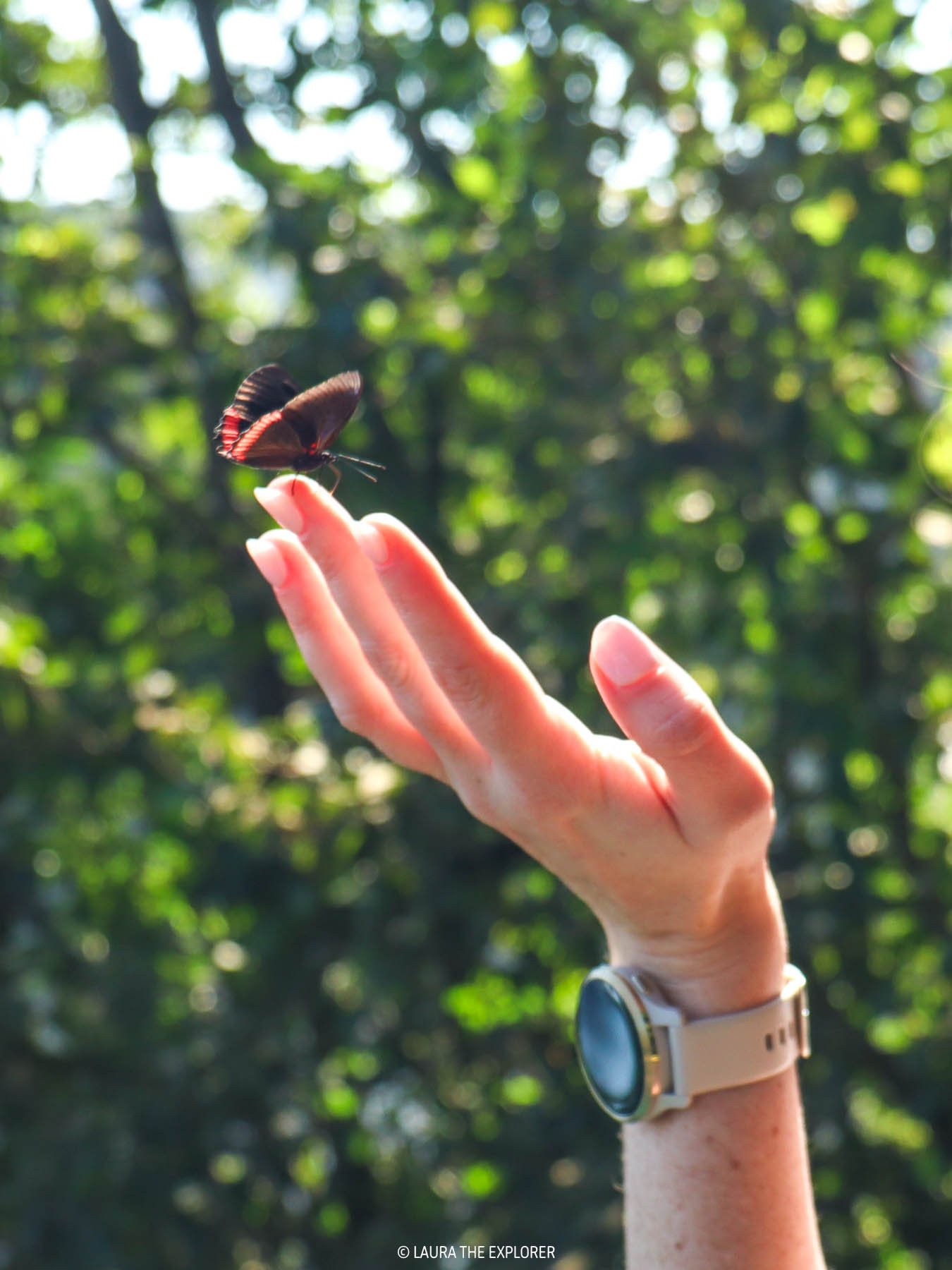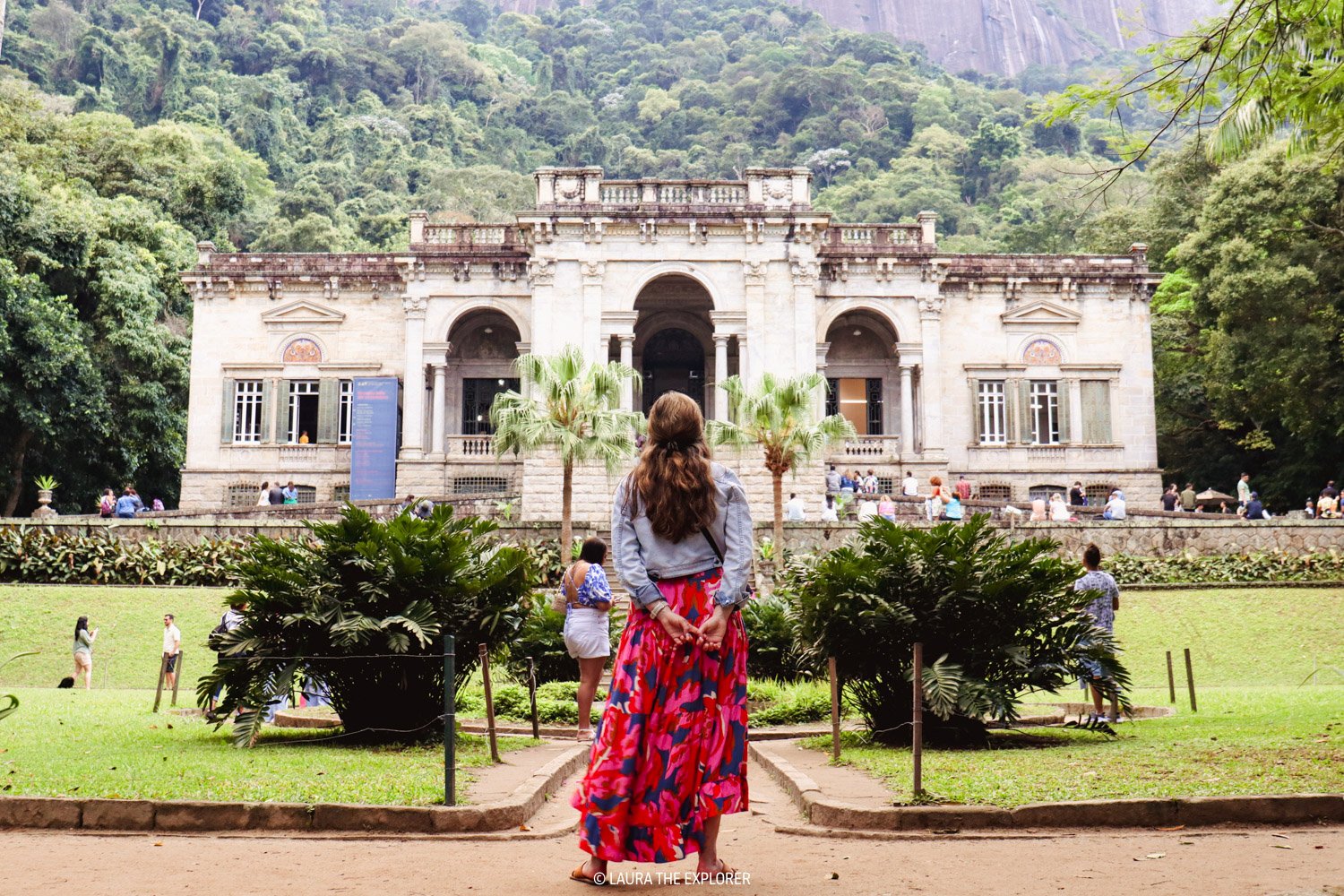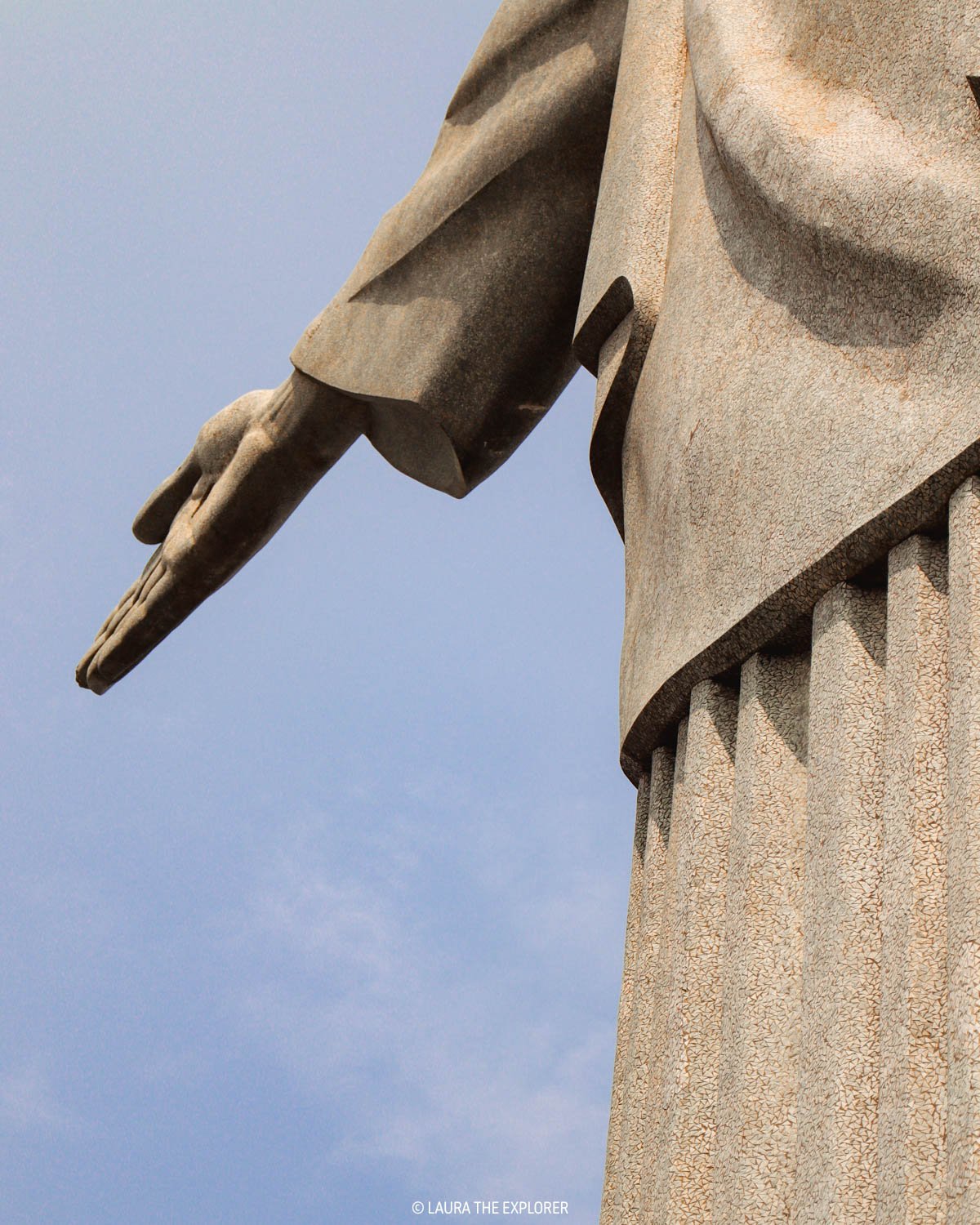A Guide to the Brazilian Side of Iguazu Falls
One of the 7 Natural Wonders of the World and a UNESCO World Heritage Site, there’s no doubt that visiting the spectacular Iguazú Falls is a must-do on any South American itinerary.
Straddling the border between Argentina and Brazil, each side of the falls offers a unique perspective and will be an experience you’ll never forget, but the Brazilian side holds a special place in my heart.
I first visited as a wide-eyed 17 year old as part of my student exchange to Brazil and I remember being awe-struck by the incredible beauty and power of the falls. Fast forward (quite) a few years later and my second experience was even better than my incredible initial memories. The Iguazú Falls do not disappoint.
This guide contains everything you need to know before visiting the Brazilian side of Iguazú Falls.
A quick heads up: This post may contain affiliate links.
We only ever recommend products or services that we use (and love!). You won’t pay anything extra if you make a purchase through one of these links, but we’ll get a small commission which helps keep the blog running. Thanks for your support!
WHAT ARE THE IGUAZÚ FALLS?
The Iguazú Falls are the largest waterfall system in the world. Located on the Iguazú River, the system features approximately 275 individual waterfalls dropping from 60 to 80m in height, though the exact number varies depending on water levels as some falls merge together when volumes are high. The edge between the upper and lower sections of the falls runs over 2.7km in length in a reverse J shape. The most impressive section of the falls is called the Devil’s Throat which is located on the border of Brazil and Argentina.
Whilst not the highest or most voluminous falls in the world, they are definitely one of the most impressive due to their sheer scale and panoramic shape.
In Portuguese, the falls are known as the Cataratas do Iguaçu, whilst in Spanish, they are known as the Cataratas del Iguazú.
The Iguazú Falls
WHERE ARE THE IGUAZÚ FALLS?
The Iguazú Falls are located on the Iguazú River which separates Brazil and Argentina.
On the Brazilian side, the Iguazú Falls are located in the state of Paraná, next to the town of Foz do Iguaçu. On the Argentinian side, the Iguazú Falls are located in the Misiones province, next to the town of Puerto Iguazú.
Slightly downstream from the falls, where the Iguazú River meets the Paraná River, is the intersection of three countries - Brazil, Argentina and Paraguay. The main border town of Paraguay is called Ciudad del Este in the Alto-Paraná region.
HOW TO GET TO THE IGUAZÚ FALLS FROM WITHIN BRAZIL?
GETTING TO FOZ DO IGUAÇU
The easiest way to reach the falls from within Brazil is by flight or bus to the nearby town of Foz do Iguaçu. The falls are a major tourist destination within Brazil, so the town is well served by domestic airlines and bus companies.
Flights on Brazilian airlines Azul, Gol and LATAM arrive predominantly from São Paulo, Rio de Janeiro, and Curitiba, though connect from throughout Brazil. Seasonal flights also arrive from Chile & Uruguay.
The airport is located on the main road between the town of Foz do Iguaçu (commonly referred to just as Foz) and Iguaçu National Park. It’s so close that it’s only a 10 min drive from the airport to the National Park containing the falls.
Overnight buses, predominantly from Curitiba, but also further afield, arrive at the main bus station in central Foz do Iguaçu.
GETTING FROM FOZ TO IGUAÇU NATIONAL PARK
The Brazilian side of the Iguazú Falls are located within the Iguaçu National Park.
From either the airport or the centre of Foz, it’s easy to reach the National Park via Uber, taxi and public bus. There’s also a large car parking area if you arrive with your own (or rented) vehicle.
Be aware that when leaving the national park after your visit, it can be difficult to connect to an Uber. This is due to patchy cellphone coverage and a lack of cars waiting in the vicinity.
On arrival at the Iguaçu National Park you’ll find the visitors centre. Here you’ll find the ticket office and the queue for the national park bus that you’ll need to reach the falls.
Whilst it’s highly recommended to buy tickets for your preferred time slot well in advance, it can be possible to buy tickets on arrival, but only if there’s spare capacity. You’ll be allocated the next available time slot which may be hours (or days!) away.
GETTING TO THE ACTUAL IGUAÇU FALLS PROPER
At the visitor’s centre, you’ll line up with your time slot group to take the bus into the park. The time slots are arranged to avoid overcrowding on the buses, and once you hop off, there’s no need to stay with the group, and you can stay at the falls as long as you like until the last bus of the day.
There are a couple of different bus stops within the park. The first two stops are for specific tours - the Poço Preto Trail Stop and the Macuco Safari Stop. Only get off at these if you have specific tickets for these tours. The bus will only stop at these stops if required.
The next two stops are to access the falls.
The Path of the Falls stop is the one I recommend getting off at. You’ll know you’re at the right spot if you’re outside the luxurious, pink Belmont Hotel das Cataratas.
From here, you’ll follow a path along the edge of the river and get to take in incredible views of waterfalls along the way. There’s also a chance to spot the local bird life. The path is not strenuous and is suitable for children and strollers, and will led you all the way to the main viewpoints on the Brazilian side of Iguacú Falls.
Alternatively, if you have limited mobility, take the bus all the way to Porto Canoas which is the end of it’s route. From here it’s a short walk and either stairs or a lift (elevator) to the main viewing platforms of the falls.
Once you’ve finished your visit, take the bus from Porto Canoas back to the Visitor’s Centre.
HOW TO GET TO THE BRAZILIAN SIDE OF IGUAZÚ FALLS FROM ARGENTINA?
It’s definitely possible to visit the Brazilian side of Iguazú Falls as a day trip from Puerto Iguazú in Argentina. If using public transport allow a full day, otherwise allow half a day with either a taxi or your own transport.
GETTING TO PUERTO IGUAZÚ
Puerto Iguazú is the main town serving the Argentinian side of the Iguazú Falls, located just across the river from Foz do Iguaçu.
The falls are also a major tourist destination within Argentina and readily served by flights and buses from across the country, though predominantly from Buenos Aires. The airport, Cataratas del Iguazú, is located right next to the Iguazú Falls Park - less than a 10 min drive away.
From the airport to the town of Puerto Iguazú, buses depart every 30 mins and take 30 mins. Taxis are also available, but given the small size of the airport, they may be limited to suit flight arrivals/departures only.
Coach buses arrive into the bus station in central Puerto Iguazú.
GETTING FROM PUERTO IGUAZÚ IN ARGENTINA TO IGUAÇU NATIONAL PARK IN BRAZIL
BY PRIVATE DRIVER
The easiest way to visit the Brazilian side of the Iguazú Falls on a day trip from Puerto Iguazú is by using a private driver. They will help arrange the paperwork in advance (though this will depend on your country of origin!), take you through the Argentina/Brazil border, and on to the Iguacú National Park. They will arrange a collection time with you, then meet you after your visit and reverse the process back to Argentina.
Expect to pay US$50-60 for the return trip, however this may fluctuate given the instability of the Argentinian peso.
I’d recommend heading out first thing in the morning to avoid any border traffic.
We did this process in reverse (Brazil-Argentina-Brazil) travelling on our New Zealand passports. In our experience it was very simple, as both the Argentinian and Brazilian customs officers were very accustomed to visitors popping across the border for the day, and we receive 90 days as tourists from both countries.
The process was recently streamlined to the point where our driver had done all the paperwork up front and we only to pop into immigration to quickly show the paperwork and our passports. This avid passport-stamp collector was a bit sad that the process was so streamlined that it no longer warranted a stamp in her passport!
BY PUBLIC TRANSPORT
It’s also possible to visit the Brazilian side of the Iguazú Falls by public transport from Argentina. You’ll need to allow for a full day however, due to the potential for having to change buses at the border. I you have the time, this is the cheaper option.
Buses leave frequently and run from Puerto Iguazú main bus station to the Brazilian National Park, or to the international bus station in Foz do Iguaçu. No schedule is available online, but buses generally leave every half an hour. Check with your accommodation or pop by the bus station to confirm timings.
You will need to stop at the border to clear immigration. I’ve received varying reports on whether the bus will wait for you, or whether you will need to get off the bus with all your gear, clear immigration, then board the next bus passing through. If you’ve done this recently, I’d love to know about your experience!
From the Foz do Iguaçu Argentinian Bus Station on Rua Mem de Sá in central Foz, switch to the adjacent Urban bus terminal and take bus 120 which runs to Iguaçu National Park. These also run approximately every 20 minutes and take about 30 minutes - the full schedule is available on the Moovit app or www.foztrans.pr.gov.br (Portuguese only).
To return, take bus 120 from Iguaçu National Park back to the bus station in central Foz, and then take the international bus back over the border to Argentina. Similarly, buses back to Argentina run approximately every half an hour, and you may need to switch buses after clearing immigration.
The international bus will cost US$2-3 each way (the exact price in pesos is difficult to provide due to the fluctuation of the Argentinian currency).
The 120 bus from central Foz to the National Park costs a little over US$1 each way.
BY TOUR
Taking a tour from Argentina to the Brazilian side of Iguazú Falls is also an easy option.
There are many options available, including tours to both sides of the falls, single and multi day trips, and the ability to add on additional features such as nature tours, boat rides and
This Full Day Iguazu Falls Tour takes in both the Argentinian and Brazilian sides of the falls.
The Argentinian side of the Iguazú Falls
HOW TO BUY TICKETS FOR IGUAZÚ FALLS
Tickets for the Iguazú Falls can be purchased through the official websites.
The official site for the Brazilian side of the Iguazú Falls is: www.cataratasdoiguacu.com.br
For the Brazilian side, note the English language option is right at the very bottom of the ticket landing page.
Tickets are available in 30 minute time slots, with a total of 350 tickets available per time slot.
The official site for the Argentinian side of the Iguazú Falls is: https://iguazuargentina.com/en/
For the Argentinian side, note that there is no English language option, and you will need to create an account with the Argentinian National Parks in order to buy a ticket.
Alternatively, to avoid the language barrier you can book a tour or tickets through GetYourGuide:
Tour & tickets for the Brazilian side are available here.
Tour & tickets for the Argentinian side are available here.
WHAT TO SEE AT THE IGUAZÚ FALLS?
THE WATERFALLS PATH (TRILHA DAS CATARATAS)
Follow the path along the edge of the river, where you will experience panoramic views of the hundreds of waterfalls. There are various viewpoints along the trail from which to admire the various sections of the falls.
Be sure to head out onto the platform for the best views through to the Devil’s Throat fall - perched over the falls get ready to really feel the force of the water.
SALTO FLORIANO DECK
Head to the upper viewing deck to get up close and personal with Floriano Fall.
MACUCO SAFARI TOUR
Discover the flora and fauna of the rainforest on the Macuco Safari Tour. Think monkeys, tropical birds like macaws and toucans, snakes, and you might even spot an elusive jaguar! This tour can be booked either in advance or on arrival in addition to your ticket.
JETBOAT RIDES
Prepare to get drenched on a boat ride under the Iguazú Falls! Departing every 20 minutes, these can get very popular and you may need to queue for some time. It’s also possible to book a timeslot in advance or on arrival in addition to your ticket..
HELICOPTER RIDES
For a birds-eye view, consider taking a helicopter tour. Whilst tours are short, lasting only about 10 minutes, you’ll get a really unique view of the falls. Helicopter tours can also be booked either on arrival or in advance for an additional cost.
If you’re planning on taking any of the safari, boat or helicopter tours, you’ll need to allow another couple of hours for your visit.
WHEN IS THE BEST TIME TO VISIT THE IGUAZÚ FALLS?
THE BEST TIME OF DAY TO VISIT THE IGUAZÚ FALLS
The best time of day to visit the Brazilian side of the falls is either first thing in the morning or late in the afternoon.
During the high season from mid-December to the end of January, plus around other public holidays, the first time slot to visit is 8am. During the rest of the year, the first time slot is 9am. This is time the first bus departs the visitor centre, so you will need to arrive 15-30 minutes before this.
The last time slot to visit is 4pm. This is the time the last bus departs from the visitor centre.
The last bus departs from the falls back to the visitor centre at 5:30pm, so you will only have a little over an hour at the falls with this option. I’d recommend taking a departure slightly earlier, say 3pm, for a decent amount of time at the falls before taking one of the last buses to depart.
THE BEST SEASON TO VISIT THE IGUAZÚ FALLS
There’s really no bad time to visit the Iguazú Falls! Whilst the rainy (summer) season sees the falls absolutely pumping, it’s also the busiest time to visit. Alternatively, tAhe dry (winter) season sees the falls running at lower volumes, the crowds are also a lot lower.
As the falls are still incredibly impressive even with lower volumes, if you’re able to pick the best time to visit, I’d chose a day that’s clear of weekends, public holidays, and school holidays in both Brazil and Argentina. Domestic and neighbouring South American visitors make up the bulk of those visiting the falls, so picking a day when they’re more likely to be at school/work will give you the best chance of lower crowds!
Floriano Fall pumping in September
WHAT TO TAKE TO VISIT THE IGUAZÚ FALLS?
There are a few things you should bring when visiting the Brazilian side of the falls, especially if you plan on taking the boat ride on the river below the falls!
A CHANGE OF CLOTHES| if you’re planning on taking the boat ride below the falls, bring a change of clothes. No matter how good your rain jacket or poncho is, you’re going to get drenched.
A RAIN JACKET OR PONCHO| even if you’re not planning on taking a boat ride, a reusable poncho or jacket is a good idea. Walking the main platforms on the Brazilian side of the falls will include a good amount of wind-swept mist.
FLAT SHOES | the main platform out over the falls gets pretty wet, so wear flat shoes that are unlikely to slip. High heels would be treacherous! I lived in my trusty Tevas throughout our time in Brazil.
SNACKS & WATER | Food and beverages are available in the park (for a premium), but bringing your own food is also permitted. And because it’s Brazil, you’ll also find beer stands to assist with ‘hydration’ along the trails!
A BACKPACK OR BAG | to at least keep your snacks in. You’ll likely become acquainted with the local coatis who will gladly relieve you of your food at any opportunity! Keep food well zipped up and out of reach. A backpack is also handy to keep your things dry when out on the misty viewing platforms. I'm currently running this Longchamp backpack or this Fjallraven cross-body bag.
WATERPROOF CAMERA CASE | if you’re bringing along camera gear like a DSLR, bring a waterproof cover as you’re likely to get mist or spray on your gear.
BINOCULARS | if you’re keen to spot the local birdlife (like toucans and macaws!) a pair of travel binoculars (and a good zoom lens) will come in handy.
SUN PROTECTION | whilst the trails are lined with trees, you’re still going to get exposed to a lot of sun. Pack the sunscreen, a hat, and a coverup for sunny days.
MOSQUITO REPELLENT | Not surprising given the rain forest environment, mosquitos can hang out in the National Parks. Bring repellent! I personally prefer one with DEET as I seem to be a tasty target for mosquitos! Repel has a great range of DEET and natural options
YOUR PASSPORT | If you're crossing the border between Argentina and Brazil, don't forget to bring your passport (and any other visa documentation you may need).
A poncho or rain jacket is essential at Iguazú Falls!
HOW LONG TO SPEND AT THE BRAZILIAN SIDE OF THE IGUAZÚ FALLS?
At an absolute minimum, allow two hours for visiting the brazilian side of the Iguazú Falls. This will allow time for the bus in and out, and walking the trails along the river to the main viewing falls, but not much spare time to relax and enjoy the views.
If you want to take your time and lots of photos, allow about 3 hours.
If you’re planning on taking a safari tour, a boat ride under the falls, or a helicopter ride above the falls, allow extra time as advised by your guide or the advice where you buy your tickets.
WHERE TO STAY IN FOZ DO IGUAÇU?
Some of the best hotels in Foz do Iguaçu (in my opinion!):
LUXURY | If you're looking to splurge for your stay at the Iguazú Falls, look no further than Belmont Hotel das Cataratas. Located within the national park, this is the place to stay if you want to avoid the crowds and experience as much of the rainforest as possible.
MID-RANGE | We stayed at Eco Cataratas Resort, located on the main road between central Foz and the National Park, which was super convenient and highly recommended.
BACKPACKER | The popular, long-running Hostel Bambu is well located in central Foz.
WHERE TO STAY IN PUERTO IGUAZÚ?
Some of the best hotels in Puerto Iguazú:
LUXURY | Similar to the Brazilian side, if you're looking to splurge on a luxurious experience, Gran Meliá Iguazú is located within the Argentinian National Park for a close-up stay.
MID-RANGE | Located in the town centre with beautiful gardens and a pool and spa facilities, Hotel Saint George is a highly-rated choice.
BACKPACKER | Family run Tucan Hostel is well kitted-out and well located in central Puerto Iguazú.
TRAVEL INSURANCE FOR SOUTH AMERICA
Safe Travel NZ says is best: if you can’t afford travel insurance, you can’t afford to travel.
We always take out travel insurance for the full duration of our trip, and it’s helped out more than once.
If you travel frequently or are planning an extended trip, check out SafetyWing.
SafetyWing offer monthly subscription-based medical and travel insurance with long term travellers and digital nomads in mind.
FAQs
HOW IS THE WEATHER ON THE BRAZILIAN SIDE OF IGUAZÚ FALLS?
The Iguazú Falls are located within a tropical rainforest, therefore the weather is typically warm and humid. The winter (dry season) runs from June to August, where water levels, temperatures, and crowds are all lower. The summer (rainy season) runs from December to February, where water levels, temperatures and humidity, and crowds are all higher.
WHAT ARE SOME OTHER THINGS TO DO ON THE BRAZILIAN SIDE OF IGUAZÚ FALLS?
Other popular activities in Foz do Iguaçu include:
Visiting the Tres Fronteiras (Triple Borders) landmark (tickets required).
Or, take a tour of the impressive Itaipu Dam, the largest hydro-power dam in the world.
DO YOU NEED A VISA TO VISIT THE BRAZILIAN SIDE OF IGUAZÚ FALLS?
You may need a visa to visit the Brazilian side of the Iguazú Falls, though most European, North American and Oceania countries are visa-exempt for 90 day tourist visits.
You may need a visa to visit the Argentinian side of the Iguazú Falls, though similarly, most European, North American and Oceania countries are visa-exempt for 90 day tourist visits.
Always check the latest visa requirements with your local embassy.
SHOULD I VISIT THE ARGENTINIAN OR BRAZILIAN SIDE OF THE OF THE IGUAZÚ FALLS?
In my opinion, you shouldn’t pick which side of the falls to visit, you should visit both!
The general guide to the falls is that the Brazilian side is where you see the falls and the Argentinian side is where you get amongst the falls. Brazil is the wide-angle, Argentina is the close-up.
I’d highly recommend making enough time in your itinerary for both! One and a half days in either Foz do Iguaçu or Puerto Iguazú will let you visit both sides comfortably.
Planning a trip to Brazil? Check out: 3 Week Brazil Itinerary & Travel Guide
AUTHOR BIO
Laura is a travel addict who’s been traversing the globe for over 15 years. After collecting all that experience, she’s now sharing her travel advice here. When she’s not out-of-office, she’s planning her next adventure and trying to keep her plants alive.
This blog post was about:
» Looking for more guides to Brazil? Try one of these:





